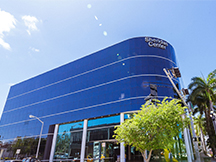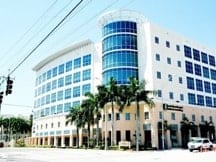Peroneal Tendon Repair
Book Your Free Consultation
What is peroneal tendon repair?
A peroneal tendon rupture occurs when one or both peroneal tendons are torn, interfering with the functions of the foot and ankle. There are two main types of tears involving the peroneal tendons. One is a tear directly across the tendon, where the torn tendon ends separate, resulting in total discontinuity of the peroneal tendon, resulting in loss of function of the respective tendon. The other type of peroneal tendon rupture is a tear that occurs within the structure that splits the tendon (or a portion of the tendon) in half the long way so that the tendon remains functional.
Causes: Peroneal tears are the result of an injury, whether it be an acute injury or chronic overuse of the tendons that ultimately lead to a tear. Acute peroneal injuries generally occur when the foot turns inward on the ankle. The peroneal tendons can become injured in this scenario because they react by strongly contracting to counteract that inversion force, and when over-stretched or over-exerted, the tendon(s) can tear. Acute injuries can cause an immediate discontinuity of the tendon or a small tear of the tendon that can enlarge over time. Overuse of the peroneal tendon can lead to tears, especially when associated with high arched feet and/or unstable ankle ligaments that cause overexertion on the tendons. At times, boney prominences can irritate the tendons as they glide around the ankle, leading to chronic tears and/or splits in the tendon.
Sign & Symptoms: Acute peroneal tendon injuries are associated with specific trauma and often present with pain and swelling on the outside area of the ankle. It is possible for pain to manifest directly over the peroneal tendon rupture. A loss of tendon function can be detected but because there are two peroneal tendons, it can be deceiving to determine if a tendon is ruptured because the other tendon may function in its place. The symptoms of a chronic peroneal tendon tear/rupture can be subtle to intense. Pain is usually worse with activity, while swelling is common with chronic injuries.
Diagnosis and Treatment: Peroneal tendon problems are diagnosed with clinical exams and advanced imaging. Depending on the extent of the rupture, patients may have weakness when the specific muscle is tested by the podiatrist. Radiographs are useful to exclude other causes of foot and ankle problems.
Magnetic Resonance Imaging (MRI) is the optimal imaging study used to look for peroneal tendon pathology, making large tears with tendon discontinuity easily visible. Although tears can be identified via MRI, there can be false positives in the location where the tendon curves around the bend of the ankle. Fluid around the tendon generally indicates inflammation, while fluid within the heel bone may be associated with prominent bone rubbing against the tendons.
The foundation for peroneal tendon surgery is to repair the ruptured, torn and/or split tendon. The type of tendon repair depends on the location and extent of the rupture and whether there is discontinuity of the tendon.
End-to-End Repair: An end-to-end rupture is repaired with strong suture. The suture is weaved on each tendon end and then the ruptured tendon ends are tied together.
Tubularization: Also referred to as a longitudinal split, splits within the tendon are more commonly seen with chronic peroneal tendon ruptures. Small simple splits can be repaired by suturing the split together with an intratendinous stitch technique. At times, the split occurs off the central axis of the tendon and excising the smaller portion of the tendon is required. The remaining portion of the tendon is then repaired and made round again by a suture technique known as tubularization.
Tendon Transfers: There are times when the peroneal tendon rupture and surrounding tendon degeneration makes the peroneal tendon unsalvageable. In this case the entire diseased portion of the peroneal tendon is completely excised. To restore continuation and functionality to the peroneal tendon, another tendon can be transferred to replace the function of the damaged tendon.
The Peroneal Stop Procedure: If one or both peroneal tendons are deemed unsalvageable, the other peroneal tendon can be used to function for both tendons. After the damaged portions of the peroneal tendon is removed, the peroneal tendon stump ends are sutured/secured to the other functioning peroneal tendon. This peroneal stop procedure is effective as both peroneal tendons have identical functions on the ankle joint as a stabilizer and similar functions on the foot. Additionally, the two peroneal tendons are located adjacent to each other so surgeons do not have to transfer a tendon from another area of the foot or ankle. The only caveat for this surgery is that the function of the peroneus brevis tendon must be maintained at its insertion onto the outside of the foot at the 5th metatarsal. The peroneus brevis function is more important than the peroneus longus function, and efforts should be made at recovering peroneus brevis function first.
Tendon Grafts: Tendon grafts are also used in peroneal rupture surgery when both tendons are deemed unsalvageable, and when the peroneal stop procedure can’t be performed. Surgeons can harvest tendon grafts from another part of the body or use an allograft from a cadaver.
Excision of enlarged peroneal tubercle: The peroneal tubercle is the normal prominent portion of the outer heel bone that acts as buttress to the peroneal tendons. In some instances, this bone is prominent, swollen, and/or misshapen – causing improper functionality of the tendon against the bone. In some cases, this bone should be filed down to prevent further or future damage.
Recovery: Recovery after peroneal tendon repair surgery generally involves a period of immobilization. Small simple repairs may allow for immediate walking in a removable boot, whereas complicated repairs may require a cast and crutches for up to six weeks. Physical therapy is recommended as post-surgery care.
Dr. Ray Lopez
Minimally Invasive Bunion Surgery

- Main Office:
- Miami Beach 400 Arthur
- Godfrey Road Suite #412
- Miami Beach, FL 33140

- South Miami
- 6200 Sunset Drive Suite #402
- South Miami, FL 33143

- Pembroke Pines
- 601 N. Flamingo Road
- Suite #101, Pembroke Pines, FL 33028

- Aventura
- 21000 NE 28th Ave.
- Suite #203, Aventura, FL 33180






